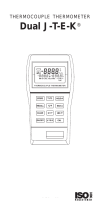
Instruction Manual pH 5+, pH 6+, Ion 6+
-1-
Table of Contents
1. INTRODUCTION......................................................................... 2
2. GETTING STARTED................................................................... 3
2.1 Description of Keypad Functions....................................................................3
2.2 Description of LCD Annunciators....................................................................4
2.3 Inserting & Removing the Rubber Armor / Stand............................................4
2.4 Inserting New Batteries ..................................................................................5
2.5 Battery Replacement......................................................................................5
2.6 Connecting the Electrode and Temperature Sensor.......................................5
2.7 Conditioning the pH Electrode........................................................................6
2.8 Switching the Meter On..................................................................................6
3. CALIBRATION............................................................................ 7
3.1 pH Calibration.................................................................................................7
3.1.1 pH Calibration Procedure............................................................................7
3.1.2 Changing the pH Buffer Group....................................................................8
3.1.3 Resetting User Calibrated Values...............................................................9
3.2 Ion Calibration (Ion 6+)...................................................................................9
3.2.1 Ion Calibration Procedure.........................................................................10
3.3 Millivolt (mV) Calibration (pH 6+ only)...........................................................12
3.4 Temperature Calibration...............................................................................13
3.4.1 With Temperature Probe...........................................................................13
3.4.2 Without Temperature Probe (no ATC) ......................................................14
4. MEASUREMENT ...................................................................... 15
4.1 Taking Measurements..................................................................................15
4.2 Millivolt (mV) Reference Check (Ion 6+ only)................................................15
4.3 Holding a Reading........................................................................................15
4.4 Releasing a Held Reading............................................................................15
5. ELECTRODE CARE AND MAINTENANCE............................. 16
6. TROUBLESHOOTING.............................................................. 16
7. SPECIFICATIONS .................................................................... 17
8. REPLACEMENTS AND ACCESSORIES................................. 18
9. WARRANTY...............................................................................20
10. RETURN OF ITEMS...................................................................20























